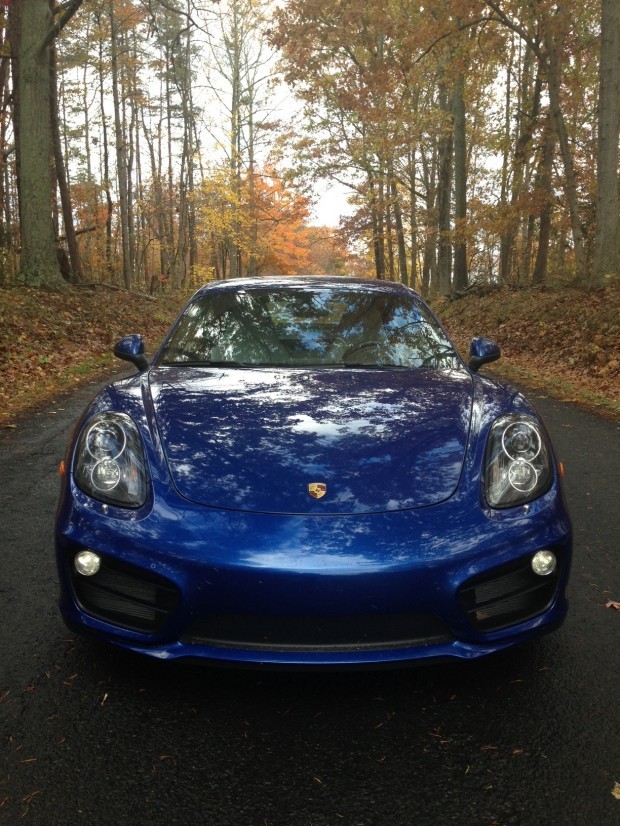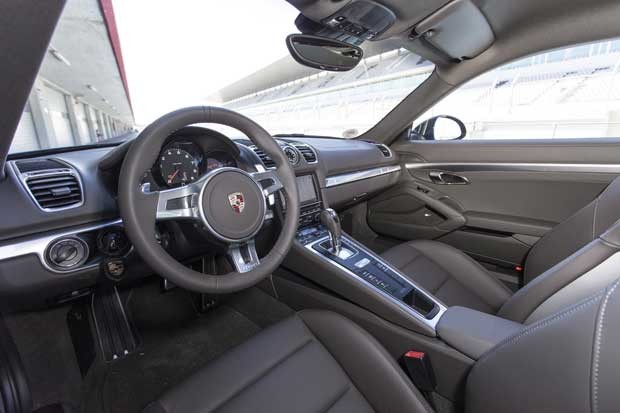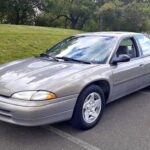The Porsche Cayman, often dubbed the “entry-level Porsche,” might sit a rung below the iconic 911 Carrera in terms of power and price. This positioning sometimes leads to the 2014 Porsche Cayman S being perceived as the “baby” of the Porsche lineup. However, to dismiss it as such would be a grave error, especially for those who truly appreciate the art of driving.
Having spent a week thoroughly immersed in the 2014 Cayman S, experiencing everything from mundane city commutes to exhilarating highway stretches and challenging mountain roads, I can confidently say this “Baby Porsche” is a serious contender for the title of ultimate driver’s car. It not only met but exceeded every expectation I had, proving itself to be much more than just a stepping stone to a “real” Porsche.
| STATS | Starting Retail Price | As Tested Price | HP / Lb-Ft |
|---|---|---|---|
| 2014 Porsche Cayman S | $63,800 | $88,625 | 325 / 272 |
| EPA Rating MPG | As Tested MPG | ||
| Rating: BUY IT! | 20 / 28 | n/a |



Under the hood, the 2014 Cayman S boasts a naturally aspirated 3.4L flat-six engine, delivering a potent 325 horsepower and 272 lb/ft of torque. My test vehicle was ideally configured with the Sport Chrono package and a 6-speed manual transmission – a purist’s dream. While a 7-speed PDK dual-clutch transmission is also available, the manual gearbox in the Cayman S elevates the driving experience to another level. The sprint to 60 mph in the manual takes a mere 4.7 seconds, just a hair behind the PDK’s 4.6 seconds (or 4.4 seconds with Launch Control). Top speed is equally impressive, reaching 175 mph in the manual version and 174 mph with the PDK.
Despite the marginal difference in acceleration figures, the manual transmission is, without a doubt, the more engaging choice for driving enthusiasts. While Porsche’s PDK is arguably the benchmark for dual-clutch gearboxes, the tactile connection and involvement offered by the manual in the Cayman S are simply irreplaceable. The clutch pedal has a perfectly judged weight, offering both feedback and ease of use, while the gear lever is positioned ideally close to the steering wheel for rapid shifts. Furthermore, the pedal placement is perfectly configured for effortless heel-toe downshifts, even for those with average-sized feet.
One of the most debated changes for this generation of the Cayman was the switch from hydraulic to electromechanical power steering. This move sparked concerns among Porsche traditionalists, fearing a loss of steering feel and purity. However, any pre-conceived notions of diminished driver engagement were quickly dispelled once behind the wheel. The new electromechanical system is nothing short of exceptional. The steering is remarkably quick and precise, with a substantial weight that inspires confidence. It’s almost flawless, with only the most minute degree of road feel possibly sacrificed. Yet, this subtle trade-off does virtually nothing to detract from the sheer joy of piloting the Cayman S. The responsiveness and accuracy are so finely tuned that the car feels like an extension of your own intentions.
The 2014 Cayman features a trio of distinct driving modes, each tailoring the car’s character to suit different scenarios. “Normal” mode is ideally suited for everyday driving, providing ample performance while maintaining a comfortable ride quality for navigating city streets. Engage “Sport” mode, now conveniently accessible via a standard button, and the throttle response sharpens, the traction control system becomes more permissive, while the steering feel remains consistent. For those seeking an even more focused driving experience, a separate button stiffens the chassis, resulting in a noticeably firmer ride – perhaps too firm for daily commuting for most drivers. “Sport Plus” mode elevates everything another notch, unleashing the Cayman S’s full potential. However, this mode is best reserved for the track, as its heightened intensity might be excessive, and frankly, irresponsible, on public roads.
The “Sport” button also serves to deactivate the automatic start/stop system, a fuel-saving feature that contributes to the Cayman S’s respectable EPA fuel economy ratings of 20 mpg city and 28 mpg highway. In practice, the start/stop system operates seamlessly: coming to a halt, shifting into neutral, and releasing the clutch smoothly shuts off the engine. When the light changes, depressing the clutch and selecting first gear restarts the engine instantly, ensuring you’re still first off the line.
Inside the cabin, the seats strike a perfect balance between comfort and support. They are plush enough for extended journeys yet provide ample bolstering for spirited driving. The wheelbase of the 2014 model is slightly longer than its predecessor, translating to a noticeable increase in cabin space. At 5’9”, headroom was abundant, with plenty of room to spare even with the seat positioned further back. Remarkably, a colleague who is 6’4” and 250 pounds also found ample space behind the wheel. True to Porsche tradition, the tachometer takes center stage in the instrument cluster, flanked by the speedometer on the left and a configurable gauge on the right, displaying navigation, temperature, or audio information. The steering wheel is substantial and wrapped in supple leather, though a flat-bottom design would be a welcome addition for added sporty flair.
The infotainment system, while functional, isn’t the most intuitive on the market, but it competently handles its tasks. My test car was equipped with the optional Burmester audio system, boasting 12 speakers and 800 watts of power. However, with a hefty price tag of $6,730, it feels like an extravagance. Frankly, the naturally aspirated flat-six provides a far more compelling auditory experience than any aftermarket sound system, no matter how premium.
The true test of the Cayman S’s handling prowess came on a winding mountain road, first in wet conditions and then again on a dry afternoon. Considering the rain-soaked pavement covered in fallen leaves and the well-worn Pirelli P-Zero summer tires, I initially opted to keep the traction control engaged during my first runs through the Appalachian mountains. The system intervened subtly but effectively when the car momentarily stepped out of line, swiftly restoring composure. As the roads dried in the afternoon, it was time to explore the Cayman S’s limits without electronic intervention. Even without traction control, the car operates on a razor’s edge of grip, yet it remains remarkably predictable and communicative. When the limit is reached, a quick steering correction is all it takes to bring it back into line. The Cayman S possesses an almost telepathic quality, anticipating driver inputs and responding with uncanny precision, making you feel like a driving virtuoso.
After experiencing the exceptional balance and poise of this mid-engine marvel, one begins to question why anyone would opt for a different Porsche, especially considering the significant price premium of $20,000+ for a base 911. While some might crave more power, the Cayman S isn’t about outright drag strip domination. It’s about the symbiotic relationship between driver and machine as you carve through corners, exploring the delicate balance between perfect execution and controlled chaos. It’s about the car reacting to your mere intentions, feeling like an extension of your will. It’s about an immersive driving experience that elevates your mood and banishes any negativity. In this car, bad days simply cease to exist.
Visually, the latest generation Cayman has matured in its design, yet remarkably, it weighs approximately 66 pounds less than the previous model. The larger side air intakes, designed to cool the mid-mounted engine, contribute to a more assertive stance. However, the Cayman’s most captivating angle is undoubtedly the rear. In a world obsessed with rear aesthetics, the Cayman’s is arguably among the finest. The rear spoiler seamlessly integrates into the taillights, blending muscularity with refined elegance.
The 2014 Cayman S starts at $63,800, but as with any Porsche, the options list can quickly inflate the price. My test vehicle, with its array of optional extras, reached an as-tested price of $88,625. Among the options, Porsche Torque Vectoring ($1,320), which enhances cornering agility by braking the inside rear wheel, is a worthwhile addition. This, however, necessitates the Porsche Active Suspension Management ($1,790) and sport suspension ($1,235) options. The Sport Chrono package ($1,850) is another essential for those intending to track the car, adding the Sport Plus driving mode. One option sorely missed on my test car was the Sport Exhaust System. While a $2,825 investment, the intoxicating flat-six engine note is an integral part of the Porsche driving experience.
Of course, the customization possibilities are extensive, and it’s easy to configure a Cayman S that encroaches on 911 territory in terms of price. Whether such expenditure is justifiable is a matter of personal finances.
In the realm of two-door, two-seat, hardtop sports cars, the 2014 Porsche Cayman S operates in a class of its own. The Jaguar XK could be considered a rival in terms of rear-wheel-drive configuration, but it commands a higher price and, despite greater horsepower, delivers slower acceleration. The F-Type is a closer match, but its convertible nature positions it more as a Boxster competitor, alongside the BMW Z4. The Audi TTS, with its all-wheel-drive system, feels like a different breed altogether. For those seeking pure rear-wheel-drive thrills and unparalleled driving dynamics, the Cayman stands alone.
On the TFLcar scale of:
- Buy it!
- Lease it!
- Rent it!
- … or Forget it!
The 2014 Cayman S earns an unequivocal BUY IT! It’s a driver-centric machine that seamlessly transitions between daily usability, backroad exhilaration, and track day prowess, all while upholding the luxurious appointments and build quality synonymous with the Porsche brand.
